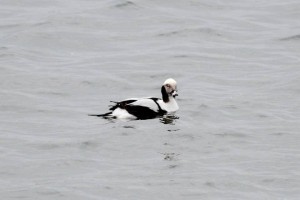Visitor Centre and Reserve News
Summer is upon us! Well not quite, but the Visitor Centre will be reverting back to its ‘summer’ opening hours from today (Saturday 1st March). This means we will be open 10.30am to 5pm, 7 days a week until the end of October.
The ‘What’s on at Montrose Basin 2014’ leaflets are also just out and include all of our most popular events from previous years like the ‘People’s Postcode Lottery Goose Breakfast’ and our Family Fun Days, along with new events such as ‘Bird-watching – an introduction for children’ and ‘Christmas goose’. To find out more about these events and when they are taking place just click on the link below to download the booklet, or pop into the Visitor Centre to pick up a copy.
http://scottishwildlifetrust.org.uk/visit/visitor-centres/montrose-basin/
On the reserve, there have been numerous Long Tailed Duck sightings over the last few weeks. These attractive visitors can be found on our shores over the winter months, having migrated from their breeding grounds in Iceland and Scandinavia. The main way of distinguishing males from females is by the presence of their long, flexible tail. Males also have a pink (sometimes grey) band on their bill throughout the year and are much whiter than the females whilst in their winter plumage. The individual in the photograph below can be identified as a male, despite the long tail not being visible, due to the presence of its white flanks and forehead.

Other sightings on the reserve over the past few weeks have included a Peregrine on the 9th, a Kingfisher on the 12th and a Water Rail on the 14th, all seen from the Visitor Centre. Numbers of Pintails have continued to be impressive throughout January and February, with groups of over 120 regularly counted. 45 Whooper swans were counted on the 13th of this month, the highest number so far this winter.
On Thursday evening there was an altogether different kind of sighting, with the Aurora Borealis (Northern Lights) displaying spectacularly over the Basin, as seen in the photograph below taken by local photographer Wendy Adie. The Northern Lights occur when electrically charged particles that are ejected from the sun cause gas atoms in the sky to glow. As the particles take two or three days to travel from the sun and into our atmosphere, it would have been earlier in the week that this event, called a coronal mass ejection would have occurred. The particles are usually pulled towards the North Pole, however, if the ejection is large enough they will be pulled closer towards the equator, and this is the reason why it was possible to see the spectacle so far south on Thursday. With it being over 20 years since the lights were seen on such a scale across the UK, we could be in for another long wait to see the spectacle in a similar fashion.

Craig Shepherd,
Visitor Centre Assistant Manager.
Help protect Scotland’s wildlife
Our work to save Scotland’s wildlife is made possible thanks to the generosity of our members and supporters.
Join today from just £3 a month to help protect the species you love.
Preface
Summer is upon us! Well not quite, but the Visitor Centre will be reverting back to its ‘summer’ opening hours from today (Saturday 1st March). This means we will be …
